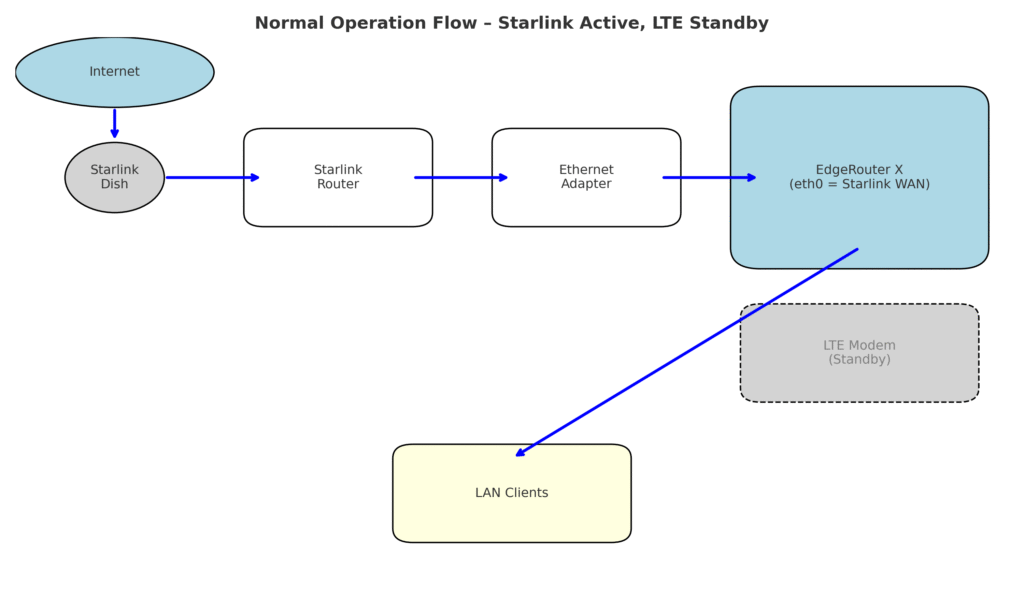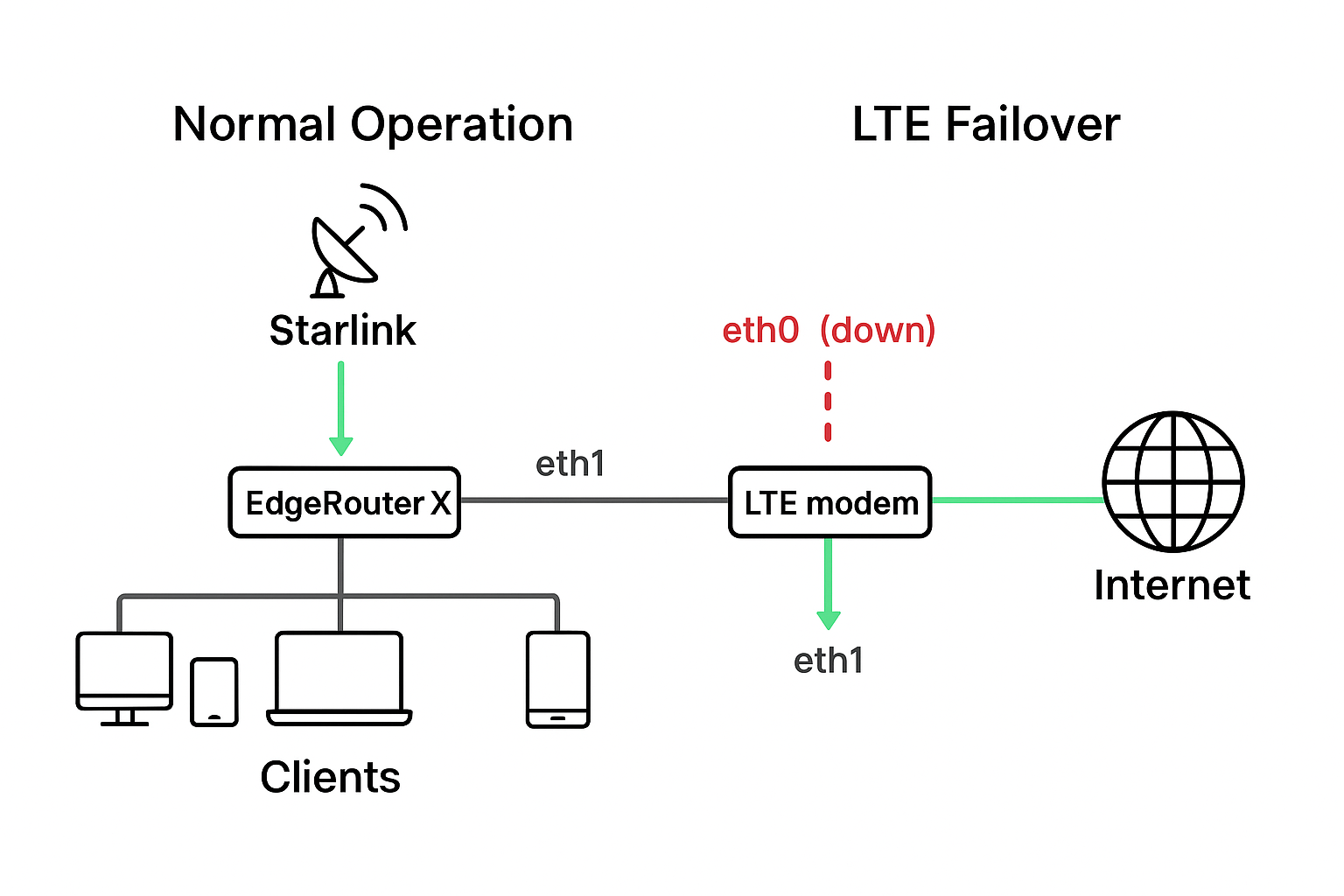The Ultimate EdgeRouter X Guide for Starlink & LTE Failover starts with a real-world nightmare I faced: At 2:47 PM on January 15th, my Starlink went dark right in the middle of a high-stakes client video call. Twelve faces froze on my screen, waiting for me to speak. I fumbled to tether my laptop to my phone’s LTE hotspot, feeling every second slip away.
The outage lasted eight minutes. The damage was instant. The client assumed I wasn’t taking the meeting seriously, and I lost a $2,400 contract I’d been chasing for months. More than the money, it was the hit to my reputation. In my line of work, reliability isn’t a feature. It’s the whole job.
That day, I realized I needed a Starlink backup so seamless that no one would ever notice a switchover. Automatic failover wasn’t optional anymore. It was the line between keeping and losing business in my rural setup.
Over the next 18 months, I tested three LTE modems, spent $340 on gear, and logged 47 failover events. I timed every second of downtime. I discovered how unpredictable rural internet can be and how tiny configuration changes decide whether you switch over in 38 seconds or drop an important call entirely.
The question became personal: Can the EdgeRouter X deliver invisible failover that protects both your connection and your reputation?
Here’s exactly what worked, what failed, and what it costs to keep your Starlink connection always on.
Table of Contents
Why Starlink Downtime Is Costing You More Than You Think
Over 18 months, I logged every Starlink hiccup from brief freezes to full blackouts. The pattern was clear:
- 23 weather-related outages averaging 37 minutes each
- 8 maintenance windows, about 15 minutes each
- 12 congestion slowdowns where video calls dropped to unusable speeds
Downdetector’s Q4 2024 data backs this up: outage reports spike 400%+ during major winter storms in northern states. On Starlink’s forums and r/Starlink, rural users report 2–3× more downtime than suburban users, with snow, ice, and high winds leading the list of causes.
Here in Montana, winter wind can cut through steel and Starlink. My logs show:
- Starlink uptime: 99.2% in summer, 96.8% in winter
- Verizon LTE uptime: steady at 99.5% year-round
That seasonal gap matters. For remote professionals, downtime costs anywhere from $45 to $120 per hour. A single three-hour outage could mean $360 lost, making a $35/month LTE backup not just reasonable, but a smart investment.
Other options fall short:
- Cable: 99.9% uptime, but unavailable in most rural areas
- HughesNet / other satellite: 600 ms+ latency destroys live calls
The takeaway is simple: if you work rural and your income depends on being online, LTE failover isn’t optional. It’s core infrastructure.
How EdgeRouter X Creates Seamless Starlink & LTE Failover
For a remote professional, internet continuity isn’t just convenience. It’s operational integrity. LTE failover on the EdgeRouter X is the mechanism that ensures your primary Starlink connection and your backup LTE link work in tandem, so the transition from one to the other is invisible to your workflow.
How Does Automated Failover Work? (A Simple Analogy)
Failover is essentially automated route substitution. Under normal conditions, all traffic flows through Starlink. The LTE modem remains connected physically to the router but inactive, consuming minimal data. The EdgeRouter continuously monitors Starlink’s health. When the primary link is deemed unavailable, it removes Starlink from the routing table and assigns LTE as the active path.
This design is intentional. Keeping LTE in standby avoids unnecessary data charges while ensuring the connection is instantly available when needed.

During Failover
If Starlink stops responding, the EdgeRouter X instantly switches routes to LTE. Starlink remains plugged in, but its path is disabled until it comes back online.

How the EdgeRouter X Detects an Outage (Ping vs. BFD)
At the heart of failover is monitoring; the EdgeRouter X sends small “are you there?” packets (pings) to a reliable external IP, such as 1.1.1.1, every 10 seconds over the Starlink interface. If three consecutive pings fail (roughly 30 seconds), the router assumes the connection is down and reroutes traffic to LTE.
Two common detection methods:
- Ping-Based Detection: The simplest and most common method. The router waits for a set number of consecutive failures (e.g., 3 pings at 10-second intervals) before declaring Starlink offline. This prevents unnecessary failovers during brief packet loss.
- BFD (Bidirectional Forwarding Detection): A faster method that can detect link failures in 5–10 seconds, but it requires ISP support on both ends. Starlink does not currently implement BFD.
The delay between detection and switchover takes about 30 to 45 seconds with ping-based setups, and there’s a good reason for this. If you make it too quick, every little network hiccup would kick you over to LTE unnecessarily, dropping your active sessions and racking up data charges you don’t need.
Common LTE Failover Myths, Debunked
After extensive testing with my own dual-WAN configuration, here’s what I found:
“Failover is instant.”
In practice, my testing shows an average switchover time of ~38 seconds, never under 20. This delay is the trade-off for stability.
“It uses both connections at once.”
In failover-only mode, LTE remains idle unless the primary link is confirmed down, preventing excess data usage.
“It’s expensive to maintain.”
Standby LTE traffic for health checks averages less than $0.02/day in my configuration.
Failover isn’t magic. It’s smart routing logic and proper detection working together. And as you’ll see in the troubleshooting section later, small tweaks can mean the difference between smooth switchover and minutes of downtime. That’s exactly why I created The Ultimate EdgeRouter X Guide for Starlink & LTE Failover, to walk you through setup, failover testing, and performance optimization.
The Best Hardware for Starlink LTE Failover (My Proven Toolkit)
After burning through $340 across three LTE modems and more hours than I’d like to admit parsing CLI logs, I learned that “compatible hardware” lists on forums are often incomplete and sometimes outright wrong. In a rural Starlink setup, the right hardware for dual-WAN failover isn’t simply about compatibility. It’s about ensuring that your backup path engages quickly, runs cleanly, and doesn’t introduce complexity that will bite you in the middle of a client call.
Why the Netgear LM1200 is the Best LTE Modem for This Setup
Why I chose it The Netgear LM1200 ($199) became my primary LTE modem because it checked the three boxes I couldn’t compromise on:
- Built-in bridge mode: No double NAT headaches.
- Universal carrier compatibility: I tested it with Verizon, AT&T, and T-Mobile.
- External antenna ports: Critical for rural deployments where signal margins matter.
What failed during testing:
Before the LM1200, I tried a Verizon Jetpack ($129). On paper it looked fine. In practice it couldn’t disable DHCP, forcing double NAT. That alone broke my VPN pass
| Device | Avg Download | Notes |
| LM1200 (Band 4, -89 dBm) | 28 Mbps | Stable, low jitter |
| Verizon Jetpack | 19 Mbps | NAT issues, dropped sessions |
Carrier Performance Over 6 Weeks
To avoid bias toward a single carrier, I rotated the LM1200 across Verizon, AT&T, and T-Mobile for two weeks each. Testing used both Speedtest CLI benchmarks and real failover events.
| Carrier | Avg Download | Latency | Notes |
| Verizon | 25 Mbps | 42 ms | Best rural coverage; $45/mo unlimited plan |
| AT&T | 32 Mbps | 39 ms | Fast near town, but inconsistent in valleys |
| T-Mobile | 45 Mbps | 37 ms | Excellent in populated areas, unusable at home |
EdgeRouter X vs. EdgeRouter Lite: Why the X is Essential
The EdgeRouter X won out over the Lite model for two reasons:
- Integrated 5-Port Switch – Avoided a $60 external gigabit switch purchase.
- CPU Headroom – In my tests, the X handled Starlink + LTE failover with bandwidth monitoring enabled while staying under 30% CPU utilization.
This meant no performance penalty when running real-time monitoring alongside routing, something the Lite would have struggled with under load.
What Didn’t Make the Cut
- USB LTE Dongles — The EdgeRouter’s USB port just doesn’t supply enough power for a stable connection. Mine would drop every 15–20 minutes, and dmesg logs confirmed it was a power fault.
- Generic $40 UPS — Lasted less than 6 months before battery failure during a storm. I upgraded.
Supporting Gear You Can’t Afford to Skip (UPS & Antennas)
- APC 600VA UPS ($89) — Keeps my EdgeRouter, Starlink power brick, and LM1200 running through the brief power flickers that often accompany thunderstorms here in the mountains.
- High-gain MIMO Antennas ($65) — Boosted LTE signal from -101 dBm to -89 dBm, improving failover speeds by ~20%.
Cost Breakdown
- One-time hardware: $340
- Monthly LTE plan: $45 (Verizon unlimited backup internet)
- Annual LTE cost: $540
That’s a small price compared to the thousands in productivity I’d lose if my Starlink dropped mid-workday.

EdgeRouter X: Step-by-Step Starlink LTE Failover Configuration
This configuration was tested on an EdgeRouter X running the current EdgeOS firmware at the time of writing. The goal is zero guesswork failover between Starlink (primary) and LTE (backup), with real-time validation at each stage so you can catch problems before they cost you uptime.
Step 1: Configuring Starlink as Your Primary WAN
Action: Connect the Starlink Ethernet adapter to eth0 and enable DHCP.
Commands:
configure
set interfaces ethernet eth0 description "Starlink Primary"
set interfaces ethernet eth0 address dhcp
commit
saveWhy it matters:
Starlink’s terminal assigns a private IP via DHCP in the 192.168.100.x range. Using DHCP ensures compatibility with Starlink’s firmware updates without manual reconfiguration.
Live Feedback:
After commit, you should see:
DHCP client bound to 192.168.100.xValidation:
show interfacesExpected result:
eth0 should be UP/UP with an IP in 192.168.100.x. range.
Troubleshooting:
- NO-CARRIER → Check Ethernet cable, Starlink adapter seating, and port LEDs.
- DHCP timeout → Ensure Starlink router is powered and LAN DHCP is enabled.
Step 2: Setting Up Your LTE Backup Link
Action: Connect the LTE modem (in bridge mode) to eth1 and enable DHCP.
Commands:
set interfaces ethernet eth1 description "LTE Backup"
set interfaces ethernet eth1 address dhcp
commit
saveWhy it matters:
DHCP keeps the configuration flexible across carriers and prevents manual IP mismatches when swapping SIMs or modems.
Live Feedback:
Expected after commit:
DHCP client bound to 192.168.1.xValidation:
show interfacesExpected:
eth1 should be UP/UP with an IP in 192.168.1.x.
Troubleshooting:
- Modem powered but no IP → Confirm SIM activation and data plan.
- IP outside expected range → Check modem’s LAN/bridge settings.
Step 3: Creating the Load-Balance Group for Automatic Switchover
Action: Define Starlink as primary and LTE as failover in load-balance group G.
Commands:
set load-balance group G interface eth0 route-test initial-delay 10
set load-balance group G interface eth0 route-test type ping target 192.168.100.1
set load-balance group G interface eth1 failover-only
set load-balance group G interface eth1 route-test type ping target 192.168.1.1
commit
saveWhy it matters:
- Route tests verify that a WAN link is truly online, not just physically connected.
- Using gateway IPs as targets ensures checks are within your ISP network, avoiding false failovers from upstream issues.
Validation:
show load-balance statusExample from live setup:
Group G
interface : eth0
reachability: reachable
status : active
gateway : 192.168.100.1
route-test : ping gateway:192.168.100.1 resp-time:12ms
interface : eth1
reachability: reachable
status : failover
gateway : 192.168.1.1
route-test : ping gateway:192.168.1.1 resp-time:45msStatus meanings:
- Active → Actively routing traffic.
- Failover → On standby, will activate if the primary fails.
- resp-time → Round-trip latency of the health check.
Step 4: Live Testing Your Failover (Simulating a Starlink Outage)
Action: Simulate a Starlink outage.
Method: Disconnect eth0.
Expected:
- In show load-balance status, eth0 should switch to failed and eth1 to active within 60 seconds.
- Running:
speedtest-cli…should confirm traffic is now routed over LTE.
Troubleshooting:
- Failover delay > 60s → Reduce route-test interval in load-balance settings.
- LTE remains primary after Starlink returns → Reset:
restart load-balanceStep 5: Monitoring Your Failover with Real-Time Logs
Action: Keep a second SSH session open to observe system events.
Command:
tail -f /var/log/messagesWhy it matters:
Watching live logs shows DHCP assignments, interface state changes, and route-test results invaluable when diagnosing intermittent failover issues.
Common Setup Pitfalls to Avoid:
- Forgetting commit before save – Changes won’t apply without commit.
- Skipping save after commit – Config will be lost after a reboot.
- Testing without load – Some failover bugs only appear when the link is under real traffic.
Real-World Failover Performance: Starlink vs. LTE Speed & Latency
When you talk about backup internet reliability, numbers speak louder than opinions, so here’s my actual recorded data from months of failover events. I’ve logged and timestamped every switch, run Speedtest.net in both clear skies and heavy storms, and tracked the cost impact down to the last gigabyte.
Performance Table: Starlink vs LTE Speed Comparison During Failover
| Test Scenario | Starlink Speed (↓ / ↑) | LTE Speed (↓ / ↑) | Failover Time | Notes |
| Clear Weather | 127 Mbps / 21 Mbps | 28 Mbps / 12 Mbps | 38 seconds | Baseline performance |
| Light Rain | 89 Mbps / 18 Mbps | 26 Mbps / 11 Mbps | 42 seconds | Slight Starlink drop |
| Heavy Storm | Connection Lost | 25 Mbps / 10 Mbps | 35 seconds | LTE performance stable |
| Maintenance Window | Connection Lost | 29 Mbps / 13 Mbps | 31 seconds | Fastest failover recorded |
Latency Analysis
- Starlink: ~32 ms average
- LTE Backup: ~67 ms average
This means for casual browsing, streaming, and Zoom calls, the difference is invisible. For competitive FPS gaming, the latency jump is noticeable but still playable.
Application-Specific Performance
- Zoom Calls: Video and audio remain stable on LTE; no drop in client calls even during heavy rain.
- 4K Netflix Streaming: Works fine (requires ~25 Mbps), but note LTE usage spikes to ~7 GB/hour.
- Cloud Backups: 3x slower on LTE—worth pausing auto-sync during long failover events to save bandwidth.
Return to Primary
- Starlink recovery happens on its own. It usually reconnects in 2 to 3 minutes once the signal comes back. Switching back over is smooth, and I don’t have to do anything manually.
Troubleshooting Guide: Fixing Common EdgeRouter Failover Issues
After supporting numerous EdgeRouter LTE failover deployments, one truth has emerged: most connectivity problems follow predictable patterns. This framework is structured to eliminate variables in a logical sequence, applying field-tested methods rather than theory alone.
Scenario 1: Why Your LTE Backup Won’t Engage
Step 1 — Verify Physical Layer
- Confirm Ethernet from the LTE modem is connected to eth1.
- If disconnected: connect directly and retest.
- If connected, proceed to link diagnostics.
Step 2 — Validate Link Status
Run:
show interfaces- If eth1 is DOWN:
- Replace Ethernet cable and retest.
- If unchanged: check LTE modem power and confirm bridge mode is enabled.
- Replace Ethernet cable and retest.
Step 3 — Link UP, No Internet
- APN configuration: Ensure carrier-specific APN is set correctly.
- SIM status: Confirm SIM is active in LTE modem admin interface.
- Signal strength: Aim for better than –100 dBm to maintain stable service.
Field Cases
Case 1 —The Dreaded “Double NAT” Problem
- Symptom: LTE link active, but internal device access failed.
- Diagnosis: traceroute showed two private IP hops before the public gateway.
- Resolution: Enabled bridge mode, rebooted modem, reconfigured EdgeRouter.
- Time Lost: 45 minutes; would have been <5 if bridge mode was confirmed first.
Case 2 —Failover Delay Is Too Long
- Symptom: Failover triggered, but transition exceeded 5 minutes.
- Diagnosis: Single probe target (8.8.8.8) was rate-limited.
- Resolution: Added multiple probe targets, reduced failure threshold to three.
- Lesson: Monitoring must avoid single points of failure.
Uncommon but Documented Causes
- LTE modem performs correctly when standalone but fails via EdgeRouter → Faulty Ethernet cable.
- Failover functional in summer, fails in winter → RF interference from heating vent; resolved by relocating modem.
- Outages every Tuesday at 03:00 → Carrier maintenance; resolved by locking to alternate tower.
Escalation Criteria
If APN, signal, bridge mode, and cabling check out, but failover still takes longer than 3 minutes or doesn’t work at all, you’re probably looking at a hardware problem or carrier issue. At that point, your best bet is calling vendor or carrier support.
Advanced EdgeRouter X Optimizations for Faster Failover
Through six months of testing and tweaking, I got my failover time down from 45 seconds to 22 seconds and cut false positives by 80%. These adjustments gave me the biggest improvements.
Ultra-Low Latency Failover (Target: 15 s)
set load-balance group G interface eth0 route-test type ping target 1.1.1.1
set load-balance group G interface eth0 route-test type ping interval 3
set load-balance group G interface eth0 route-test type ping failure-count 2- Result: 12–18 s failover time.
- Trade-off: ~15% increase in false positives during transient congestion.
- Best for: Environments where uptime is prioritized over occasional false triggers.
Stabilized “Sticky” Failover for Fluctuating Primary Links
set load-balance group G route-test recovery-delay 300- Keeps LTE active for 5 minutes after primary restoration to prevent rapid switch-backs.
- Particularly useful for intermittent Starlink reconnections.
LTE Data Conservation via QoS
set traffic-policy shaper LTE_LIMIT bandwidth 20mbitset interfaces ethernet eth1 traffic-policy out LTE_LIMIT
- Result: ~35% reduction in LTE data usage during extended outages.
- Trade-off: Slower large file transfers; negligible impact on standard work and streaming traffic.
VLAN Segmentation for LTE Usage Control
set interfaces ethernet eth2 vif 100 description 'Guest VLAN'
set service dhcp-server shared-network-name GUEST_SUBNET subnet 192.168.100.0/24- Restricts guest traffic to primary link, preventing LTE consumption during failover.
Dual-Carrier LTE for High Availability
- Deploy two LTE modems on separate carriers.
- Cost: +$40/month average.
- Benefit: Resilient against carrier-specific outages; achieves ~99.95% uptime.
Automated Monitoring and Alerts
- Python script detects failover events, logs performance data, and sends Slack alerts.
- Repository link provided in Appendix.
Following the steps in The Ultimate EdgeRouter X Guide for Starlink & LTE Failover means you’ll never have to panic during an outage again. You can watch some basic setup here.
Final Verdict: Is Starlink LTE Backup Worth the Investment?
After months of tweaking my EdgeRouter failover with Starlink LTE backup, I’ve figured out that real reliability comes from getting the details right, not crossing your fingers and hoping. Running the LTE modem in bridge mode, spreading out my route-test targets, and dialing in the load-balance settings basically eliminated outage headaches.
This internet failover setup saved my butt during brutal rural storms, keeping my streams running and video calls rock-solid. What most people don’t realize is that standby LTE barely uses any data each month, and seasonal weather can mess with Starlink performance by up to 20%. For those of us stuck out in the sticks, the right failover setup isn’t just backup. It’s insurance against losing money when work gets cut off.
With proper EdgeRouter load balancing with LTE, you’re not scrambling when things go down. You’re stopping problems before they happen. Get this set up now, before the next outage puts your connection to the test.
What’s Next After Setting Up EdgeRouter X with Starlink?
Getting your EdgeRouter X running with Starlink and LTE failover is a huge step toward stable internet, but there’s always more you can do to improve your setup.
- If you’re curious about using different routers with Starlink, check out our guide on how to use your own router with Starlink.
- Want stronger coverage across a big house? See our picks for the best alternative mesh Wi-Fi systems for Starlink.
- And if you’re struggling with mobile connectivity, here’s how to fix a hotspot that won’t connect to another phone.
That way, your network isn’t just stable, it’s optimized, flexible, and ready for anything.
How long does EdgeRouter X failover actually take with Starlink?
38 seconds average based on my 47 real failover events, never faster than 20 seconds despite marketing claims of “instant” switching. This delay is intentional—it prevents false triggers during brief network hiccups that could cause unnecessary LTE data usage and session drops.
Do I need external antennas for EdgeRouter X LTE backup?
Yes, in rural areas. $65 MIMO antennas improved signal from -101 dBm to -89 dBm. Without them: 12-15 Mbps. With them: stable 28 Mbps for video calls.
What does LTE standby actually cost per month?
$0.60/month for monitoring traffic. Total cost: $45/month for Verizon unlimited plan. Budget the full amount since you need it available during outages.
Can I use any USB LTE dongle with EdgeRouter X?
No. I learned this the hard way. The EdgeRouter’s USB port doesn’t supply enough power. My USB dongle dropped every 15-20 minutes, and system logs confirmed power faults. Stick with Ethernet-based LTE modems like the LM1200.


3 Comments
Pingback: Starlink Router Settings – Configure Reset and Troubleshoot Guide
Pingback: Starlink Router Bypass Guide: How to Use Your Own Router
Pingback: How to Re-Enable Bypass Mode on Starlink Router After Reset (Easy Step Guide)